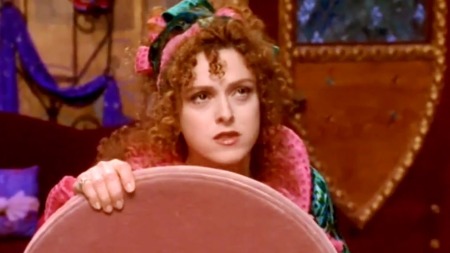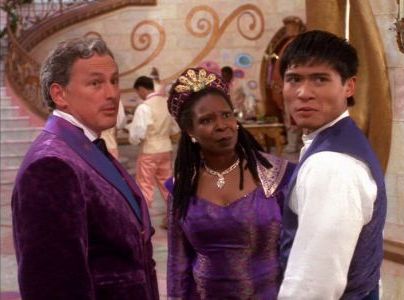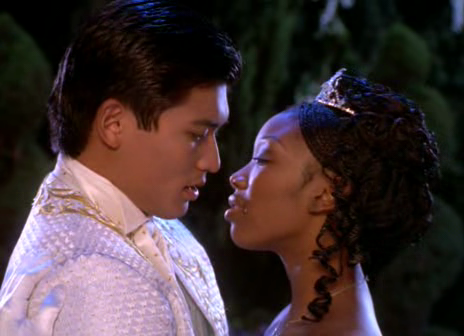Cinderella Week continues with Andrew Kendall on a true event in showbiz history...
On our journey through Cinderellas we take a stop in 1997 for an unlikely entry in the canon. Unlike the animated version it did not change a cinematic form, nor like the Julie Andrews version did it launch a star. When the 1997 TV production of Rodgers and Hammerstein’s Cinderella premiered in 1997 it was hailed as one of the most successful TV musicals in years and audiences did, love it, 60 million of them. But, it has endured as little more than a footnote on the résumé of its fêted cast and crew.
This would be the second remake of the Rodger and Hammerstein’s Cinderella written for Julie Andrews in 1957 (the first remake a Lesley Ann Warren version in 1965). And, still, I’d swear on the altar of all things magical that this is the finest adaptation of the Cinderella story. Myriad reasons, but principally because this Cinderella has more on its mind than just the girl at the centre…
Tim has already admitted that an essential issue with the 1950 Cinderella, and really any Cinderella, is her potential for being charming but somewhat dull. This television version may seem to be doing itself no favours by casting pop sensation of the 90s (and not quite an actress) Brandy Norwood in the lead role. Unlike Julie Andrews, she's no natural thespian but her general diffidence in character on screen is an integral part of this version's take on the story. In this adaptation from Robert Freedman (recent Tony winner for writing A Gentleman's Guide to Love & Murder), the Prince (disguised as a pauper to experience the real word) and Cinderella meet each other by happenstance in the town and are charmed by each other, both of them longing to leave the lives they're currently living. This Cinderella is less interested in ascending to royalty, specifically and more focused on finding somewhere away from her Stepmother, where she's appreciated. The Prince is facing his own issues of a King and Queen who want him married sooner, rather than later.
Not just changes to the libretto, this adaptation (like the 1965 one) is significant for adding other Rodgers and/or Hammerstein songs to the score. In this version, a trio. “The Sweetest Sounds” for the Prince and Cinderella (from No Strings, also about a relationship between a black budding starlet and a love interest of another ethnicity), “There’s Music In You” for The Fairy Godmother (from Main Street to Broadway) and “Falling In Love with Love” from The Boy from Syracuse. They all work, but the the latter is my favourite for a specific reason. So, I may as well get to it.

BERNADETTE PETERS!
Why, yes. I did choose this particular incarnation of the film as much as for my belief in it being top tier Cinderella but even more so for the chance to gush at Bernadette Peters’ excellence. "Falling in Love with Love" is a mere sliver of a song but becomes a key part of Peters indomitable performance here. Mary Rodgers was reportedly, initially, against the inclusion of this particular number in the score until she saw Bernadette take on it. And, why not? The number’s conceit of the Stepmother’s advice to her girls that when it comes to courtship, “This isn’t about love! It’s about marriage!” is a hoot but the pleasure of this number, and the performance, runs deeper.
It is not merely Bernadette fanaticism that has me arguing that she’s best in show. The Stepmother's de facto existence as the tale's villain has potential for sincere dramatic tension, but is rarely played that way. Too often the role is regarded as evil without cause. There is not much dramatic tension in the A plot of any Cinderella tale, but here the B plot of the family is home to delicious dramatic tension built from the references to Cinderella’s dead fathers and Peters knowing glances at her, palpably worried at the threat she poses to her girls. This is still a production meant for children, so the gradations come from performance more than text but it is there.
It all comes to a head in the film’s finest scene which is only peripherally about romance. The ladies come home after the ball (disastrous for the Stepsisters, wonderful for Cinderella) and reminisce about the possibility of “A Lovely Night” that could have been with the prince. The dramatically ironic moment as Cinderella "supposes" on what the ball would have been like finds its climax when a fateful curtsy cues the Stepmother in to Cinderella’s identify as the anonymous princess. (It’s a lovely callback to Lady Tremaine's realisation in the animated version). It's a moment that manages to eke out legitimate tension from a slight moment, and 90% of that is owed to Bernadette.

But, lest this lopsided praise song suggests this Cinderella is a Maleficent-esque tale where the Stepmother is the lead, let me confess this piece truly seems to exist as an ensemble. From Whoopi Goldberg's delightfully officious Queen Mother to Jason Alexander's harried steward to Veanne Cox's gigging Calliope to Victor Garber's noncommittal King, director Robert Iscove wants to give every one their moment. This Cinderella feels generous and kind and charming in the best of ways.
It is a charm which builds when its ethnically diverse cast is considered. Filipino newcomer at the time Paolo Montalban sings beautifully as the Prince and, yes, he and Brandy are the weakest of the cast (if only on a scale) but the melange of races on display harkens to the film's theatrical roots. Theatre has always been more willing to incorporate blind casting than film, and though I've since heard Cinderella's casting referred to as gimmicky where else but a magic kingdom can a black woman and a white man make a Filipino son with a white Steward who speaks with an (inexplicable) pseudo-Italian accent?
The film never questions the logics of its ethnicity, and neither did I as a child. Is it treacly to surmise that aspect of it as an example of impossible things happening everywhere? Probably. But, the film's opening of Whitney Houston (also a producer) as the Fairy Godmother telling us impossible things are happening everywhere is a welcome encouragement to succumb to the world offered.
This Cinderella is gorgeous with its Emmy winning Art Direction and Emmy nominated Costume Design and Hairstyling. But it’s brightly coloured sheen and spiffy choreography (courtesy of Rob Marshall's Emmy nominated work half a decade before Chicago) is not trying to hide a centre that's flat. It's the same (very) simple story, but simple aspects like this Cinderella's mourning for her dead father, or the Prince actually recognising Cinderella before even trying on the shoe make it even more effective.
This Cinderella does not suceed by overreaching, though with changes to the tale it is still simple at its heart and ultimately it aims to charm and entertain. Its closing “There’s Music In You” message is built on being heartwarming, but not disingeniously so. And it manages to do all this while being satisfying and, yes, magical.
And that is truly the best we can hope for from any Cinderella.
